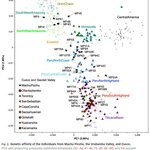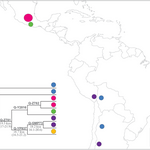Anthropology

Both Neanderthal and early modern humans used birch tar - the first time in known history that a new material came into use.
Coming up with it is one thing, but finding a way to scale it is more challenging.
To get answers, scholars used Petri net models to try and infer what kinds of cognition were required for the materials. The findings suggest Neanderthals probably relied on several cognitive traits that archaeologists often associate with modern thinking and behavior. “Neanderthals used, at least on some occasions, a complex production process to make tar," says Dr. Sebastian…

The first investigation of the genomic diversity of individuals buried at Machu Picchu and adjacent places around Cusco, the Inca capital finds that the mitmas - slaves - and members of the empire who were forced to serve elites and lived, worked, and died at Machu Picchu, the renowned 15th century Inca palace in southern Peru, were a diverse community representing many different ethnic groups.
Machu Picchu is perhaps the most famous archaeological site in the Western Hemisphere. Some social scholars now believe Machu Picchu was a royal estate connected to the lineage of Pachacuti, the…

Nearly 3 million years ago, early human ancestors used some of the oldest stone tools ever found to butcher hippos and pound plant material, and for half that time they were butchering each other - a new paper says 1.45 million years of killing each other for food.
We talk about violence a lot today because it is relatively rare compared to the past. In prior centuries, life had much less value. In the US prior to the arrival of Europeans, shocking violence was far more common than after colonization. Crimes against each other have been mollified over time, to where now people chastise each…

Cooperative breeders, where we count on the help of others to raise offspring,is not unique to humans. It may only appear that way.
A new paper amassed data from 90 human populations comprising 80,223 individuals from many parts of the world — both historical and contemporary. They compared the records for men and women to lifetime data for 45 different nonhuman, free-ranging mammals. The argue that humans are a non-exceptional species of mammal. Says first author Cody Ross, PhD, anthropologist at the Max Planck Institute; “we can quite successfully model reproductive inequality in humans and…

Ask a hunting guide about what your first experience as a novice hunter should be and they will say a turkey. No one ever cried over eating turkey whereas a rabbit would be a bad idea for many.
A new survey in Human-Animal Interactions attempted to assess social perceptions in Singapore about ‘food animals’ versus 'friends' and 'worth fighting for', broken down as ‘Love’, ‘Save’, ‘Indifferent’ and ‘Dislike.’
Using the controversial Stereotype Content Model (SCM), creatures as diverse as shark, alligator, pig, dog, octopus, rabbit, cow and orangutan were rated on scales of warmth and…

The most popular pets are cats and dogs but their origins as human companions are much different. Dogs became domesticated during the ice age 23,000 years ago as humans and wolves co-habitated in tolerable refuge areas. Scavenging and then feeding by humans led to companionship.
Pet cats (Felis silvestris catus. Felis catus) are much more recent, and evidence shows they were allowed as pest control but gradually became companions as humans migrated and took cats with them. Like dogs, and unlike cattle and horses, there was a nexus for domestication; in the case of cats the Fertile…

Count the times the word “culture” came out of reporters’ mouths last week, and you’d think they were anthropologists. Usually in this context: “The culture of white supremacy has gone fully mainstream.* “The bedrock idea uniting right-wing communities… is that white Christian men in the United States are under cultural and demographic threat.”**
It’s no surprise then that a poll shows a majority of Republicans agreeing that “the American way of life is disappearing fast.”* These respondents likely interpreted “American way of life” to mean White Protestant culture. Let’s call them the…

It is common today to have food, or even a feast, to memorialize the dead. It is a legacy from ancient times.
Across the Roman Empire, funerary rituals were conducted to ensure the protection of deities and the memory of the deceased. They were required by law.
Faunal remains recovered inside the graves and around them provide evidence that funerary meals and rituals developed in the Roman necropolis were special and implied food that differed from everyday dietary habits but a recent study analyzed the archaeozoological and anthropological material from the necropolis of Vila de Madrid…

Once upon a time, terms like 'primate' and 'Neanderthal' were used as joke insults, but they are both entirely true, and the latter even more so now.
Unlike databases of where people live such as companies like Ancestry uses to claim 'you are 12 percent Irish', biology is not a marketing gimmick. Once the science is settled, social fields like anthropology and other exploratory studies can fill in some gaps.
A new exploratory paper assessed the facial structure of prehistoric skulls, hoping to support the hypothesis that a lot of Neanderthal-Modern interbreeding took place in the Near East –…

The history of humans is a history of expansion, from the recesses of Africa outward across the world. No one is really a native and yet everyone is, because all humans were first an invasive species but if you are born in a place, you are then native.
Some will claim their ancestors lived in a place 12,000 years ago, but unless they had an individual genomic analysis it's no more valid than saying they were descended from Genghis Khan, yet science is converging on ways to go beyond the silly '12 percent Irish' claims based on 23andMe or Ancestry and really determine if your…